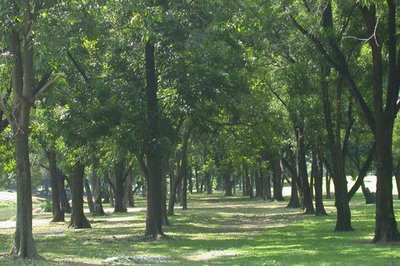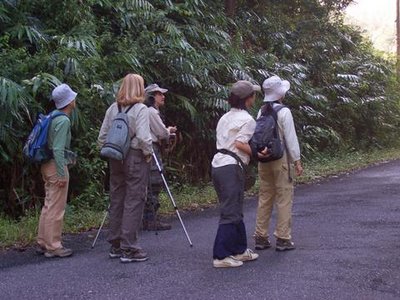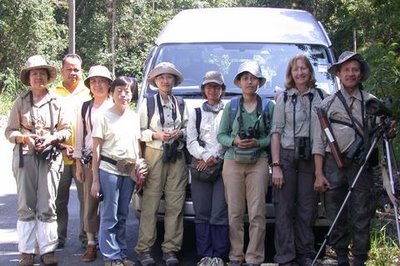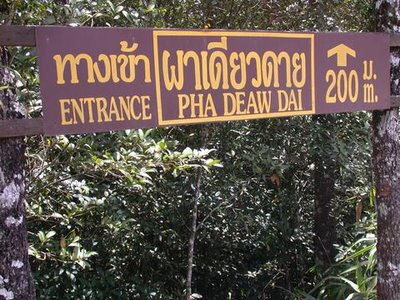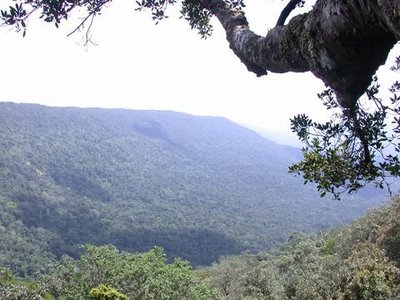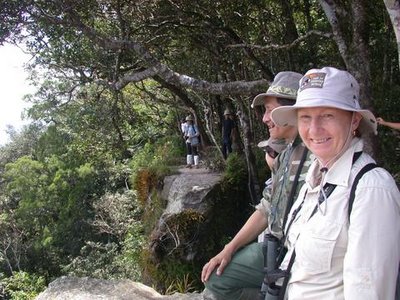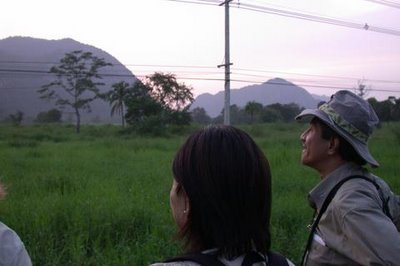Date: 23 Nov, Thursday
Time: 9am
Location: West Coast Park
What: little egret building a nest with dried branches. It placed a branch into the nest, then moved some others around.
Thailand - Rot Fai Park
Photos by Hwei Iue.
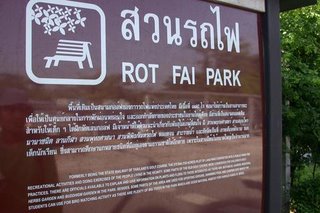 Was in Bangkok, Thailand on 25th October. Visited Rot Fai Park (Railway Park), which can be reached from Skytrain N8 Mo Chit station.
Was in Bangkok, Thailand on 25th October. Visited Rot Fai Park (Railway Park), which can be reached from Skytrain N8 Mo Chit station.
The park was the former State Railway of Thailand golf course and is now a park that covers 60 hectares.
Walking along Chatuchak Park's front wall on Vibhawadi Ransit Road, there was an Asian Pied Starling singing on a tree. Common Mynas on the grass within the park.
 Just before the main gate to Rot Fai Park, Eurasian Tree Sparrows were hopping around an old train on the left side of the road.
Just before the main gate to Rot Fai Park, Eurasian Tree Sparrows were hopping around an old train on the left side of the road.
 On entering the park, saw Chinese Pond-Herons in the lotus pond. Oriental Magpie-Robins and Pied Fantails were singing and hopping from tree to tree. They seemed rather tamed, coming within reach of one metre.
On entering the park, saw Chinese Pond-Herons in the lotus pond. Oriental Magpie-Robins and Pied Fantails were singing and hopping from tree to tree. They seemed rather tamed, coming within reach of one metre.
 Was in Bangkok, Thailand on 25th October. Visited Rot Fai Park (Railway Park), which can be reached from Skytrain N8 Mo Chit station.
Was in Bangkok, Thailand on 25th October. Visited Rot Fai Park (Railway Park), which can be reached from Skytrain N8 Mo Chit station. The park was the former State Railway of Thailand golf course and is now a park that covers 60 hectares.
Walking along Chatuchak Park's front wall on Vibhawadi Ransit Road, there was an Asian Pied Starling singing on a tree. Common Mynas on the grass within the park.
 Just before the main gate to Rot Fai Park, Eurasian Tree Sparrows were hopping around an old train on the left side of the road.
Just before the main gate to Rot Fai Park, Eurasian Tree Sparrows were hopping around an old train on the left side of the road.  On entering the park, saw Chinese Pond-Herons in the lotus pond. Oriental Magpie-Robins and Pied Fantails were singing and hopping from tree to tree. They seemed rather tamed, coming within reach of one metre.
On entering the park, saw Chinese Pond-Herons in the lotus pond. Oriental Magpie-Robins and Pied Fantails were singing and hopping from tree to tree. They seemed rather tamed, coming within reach of one metre.
Walking around the various ponds, Rock Pigeons were flying overhead, Striated Heron and Little Egret were feeding by the pond.
On an open grass patch, Richard's Pipits and Zebra Doves were moving on the ground. A Brown Shrike and an Ashy Drongo perched facing each other.
Blue-Tailed Bee-Eater and Indian Roller were doing their acrobatic flights before landing on some branches.
List of species recorded:
- Chinese Pond-Heron
- Little Egret
- Striated Heron
- Rock Pigeon
- Red Turtle-Dove
- Spotted Dove
- Zebra Dove
- Blue-Tailed Bee-Eater
- Indian Roller
- Richard's Pipit
- Ashy Drongo
- House Crow
- Warbler
- Oriental Magpie-Robin
- Asian Brown Flycatcher
- Pied Fantail
- Brown Shrike
- Asian Pied Starling
- Common Myna
- Olive-Backed Sunbird
- Eurasian Tree Sparrow
Thailand - Khao Yai 2006-10-24
Thailand - Sab Sadao 2006-10-22
Photos contributed by Bee Lan, Hwei Iue and Nessie.
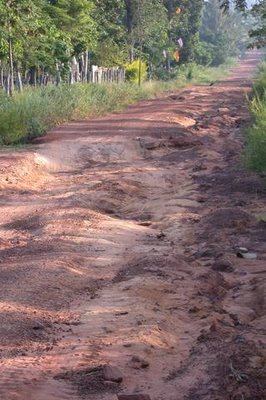




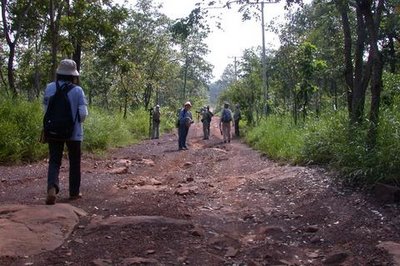


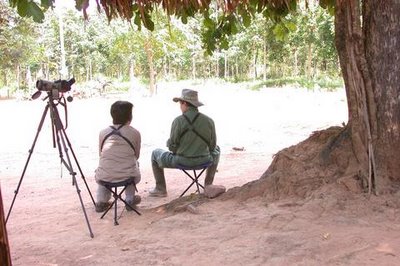

Potholes on the way to Sab Sadao.
We had to get off the vehicle at some locations, so that it can move on.
At some points, Kiat had to use rocks to fill up the holes on the ground.

Kiat laying out the chairs for our breakfast.

Breakfast time.

what do we have for breakfast?
chicken drumstick, crackers, bun, sandwich, hard-boiled eggs.

let's eat


After lunch, some of us were studying the guidebooks.

while someone is having a nap under the shelter.

Husband and wife enjoying the leisure afternoon.
Thailand - Khao Yai 2006-10-21
Photos contributed by Bee Lan and Hwei Iue.
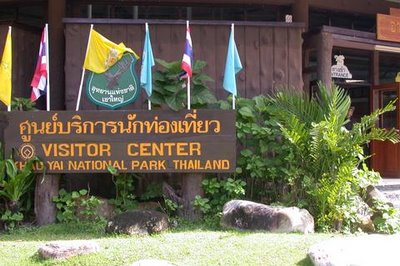
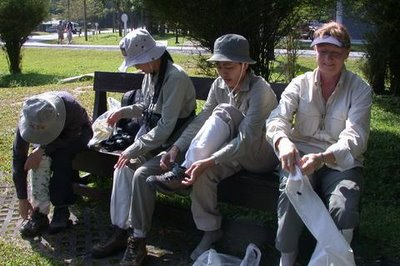




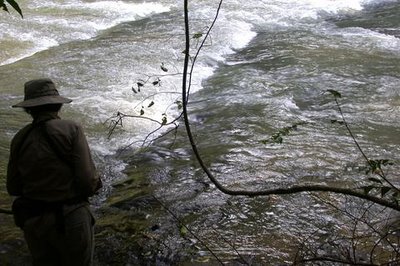


First stop for the morning.

Shopped for leech socks and hats at the visitor centre.

Getting ready for the leeches.

Here we come.




Beautiful cascades along the trail.

Some of us were attacked by these little creatures.
Jane even brought home some in her leech socks.
Thailand - Khao Yai 2006-10-20
Thailand - Khao Yai
Photos contributed by Hui Miang.
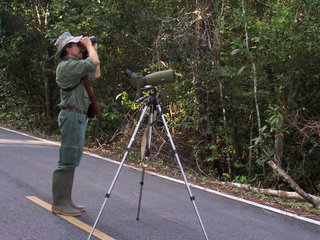
Our guide Mr Kamol Komolphalin.
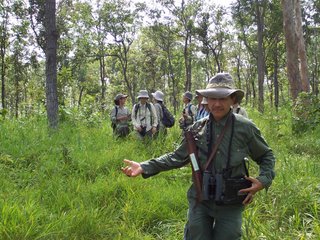
At Sab Sadao.
Kamol was playing his tapes to attract the birds.

At the summit
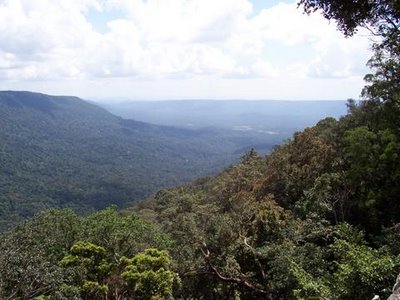
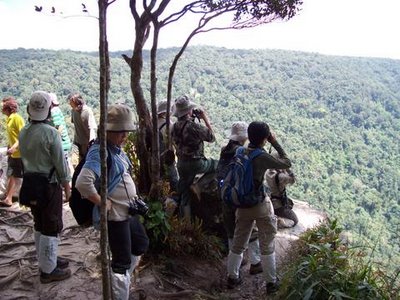
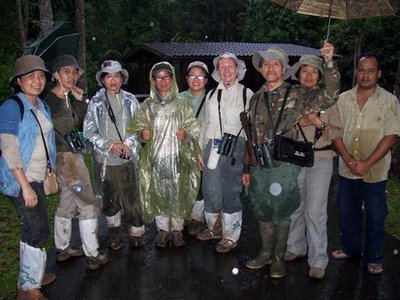
Wet and soiled after trail 6.
No pitta, but saw a trogon and a Ferruginous Flycatcher.

The last breakfast we had at Khao Yai.
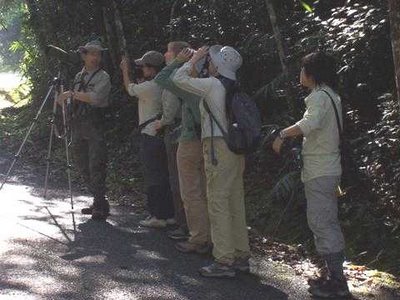
Hornbills were circling in the sky.








2006 October 29 - Jurong Lake Park
Grey Herons, Little Egret and Intermediate Egret standing in the water. Striated Heron by the water edge, some were flying over the lake to the golf course. White-Throated Kingfisher flew to rest on a low branch. Black-Naped Orioles calling away on the trees. A juvenile Tiger Shrike appeared briefly.
Lots of Pink-Necked Green-Pigeons on a Casuarina tree with some Asian Glossy Starlings when a Purple-Backed Starling came to join the crowd.
A Common Kingfisher resting on a stump across the lake. Later, saw it flew inches above the water surface, with the blue on its back shimmering in the sun.
A Pied Imperial-Pigeon flew to rest on a tree.
At the end of the lake, near Tang Dynasty, there was a fruiting fig tree. Oriental Magpie-Robin and Pied Fantail were hopping from branch to ground and onto the rock under the tree. A Crow-Billed Drongo flew from a nearby tree to join the Yellow-Vented Bulbuls and Asian Koels to pick the fruits. An Arctic Warbler and a female Yellow-Rumped Flycatcher were also spotted in the tree.
A handsome Scarlet-Backed Flowerpecker was singing in the bush.
Highlight of the day was the Ruddy Kingfisher.
More than ten “big guns” were aimed at it. The photographers were clicking away when it was trying to align a fruit between its beaks. The colour of its beak and feet was orangey red. Quite a big sized kingfisher. Doreen and I congratulated ourselves for seeing this lifer at close range.
List of species recorded:
1) Dollarbird
2) Common Kingfisher
3) Ruddy Kingfisher
4) White-Throated Kingfisher
5) Asian Koel
6) Pink-Necked Green-Pigeon
7) Pied Imperial-Pigeon
8) Brahminy Kite
9) Little Egret
10) Grey Heron
11) Purple Heron
12) Intermediate Egret
13) Cattle Egret
14) Striated Heron
15) Tiger Shrike
16) House Crow
17) Black-Naped Oriole
18) Pied Fantail
19) Crow-Billed Drongo
20) Asian Brown Flycatcher
21) Yellow-Rumped Flycatcher
22) Oriental Magpie-Robin
23) Asian Glossy Starling
24) Purple-Backed Starling
25) Common Myna
26) Javan Myna
27) Pacific Swallow
28) Yellow-Vented Bulbul
29) Arctic Warbler
30) Scarlet-Backed Flowerpecker
31) Plain-Throated Sunbird
32) Olive-Backed Sunbird
Lots of Pink-Necked Green-Pigeons on a Casuarina tree with some Asian Glossy Starlings when a Purple-Backed Starling came to join the crowd.
A Common Kingfisher resting on a stump across the lake. Later, saw it flew inches above the water surface, with the blue on its back shimmering in the sun.
A Pied Imperial-Pigeon flew to rest on a tree.
At the end of the lake, near Tang Dynasty, there was a fruiting fig tree. Oriental Magpie-Robin and Pied Fantail were hopping from branch to ground and onto the rock under the tree. A Crow-Billed Drongo flew from a nearby tree to join the Yellow-Vented Bulbuls and Asian Koels to pick the fruits. An Arctic Warbler and a female Yellow-Rumped Flycatcher were also spotted in the tree.
A handsome Scarlet-Backed Flowerpecker was singing in the bush.
Highlight of the day was the Ruddy Kingfisher.
More than ten “big guns” were aimed at it. The photographers were clicking away when it was trying to align a fruit between its beaks. The colour of its beak and feet was orangey red. Quite a big sized kingfisher. Doreen and I congratulated ourselves for seeing this lifer at close range.
List of species recorded:
1) Dollarbird
2) Common Kingfisher
3) Ruddy Kingfisher
4) White-Throated Kingfisher
5) Asian Koel
6) Pink-Necked Green-Pigeon
7) Pied Imperial-Pigeon
8) Brahminy Kite
9) Little Egret
10) Grey Heron
11) Purple Heron
12) Intermediate Egret
13) Cattle Egret
14) Striated Heron
15) Tiger Shrike
16) House Crow
17) Black-Naped Oriole
18) Pied Fantail
19) Crow-Billed Drongo
20) Asian Brown Flycatcher
21) Yellow-Rumped Flycatcher
22) Oriental Magpie-Robin
23) Asian Glossy Starling
24) Purple-Backed Starling
25) Common Myna
26) Javan Myna
27) Pacific Swallow
28) Yellow-Vented Bulbul
29) Arctic Warbler
30) Scarlet-Backed Flowerpecker
31) Plain-Throated Sunbird
32) Olive-Backed Sunbird
Fall Migration Bird Census 2006
Location: Lower Seletar Dam
Date: 2006 September 10
Time: 7:30am - 10:00am
Weather: Hazy
Tide: Low to High
Full list of species recorded:
No pigeons were seen until after we have stopped the count and were walking back to our starting point.
Two eurasian tree sparrows were seen picking the leftovers near the rubbish bin.
One brahminy kite was flying across the dam.
Date: 2006 September 10
Time: 7:30am - 10:00am
Weather: Hazy
Tide: Low to High
Full list of species recorded:
- Common Flameback
- Dollarbird
- Collared Kingfisher
- Asian Koel
- Red-Breasted Parakeet
- Spotted Dove
- White-Breasted Waterhen
- Common Sandpiper
- Mongolian Plover
- Whiskered Tern
- Little Egret
- Grey Heron
- Great Egret
- Striated Heron
- Golden-Bellied Gerygone
- House Crow
- Black-Naped Oriole
- Common Iora
- Asian Glossy Starling
- Javan Myna
- Barn Swallow
- Pacific Swallow
- Yellow-Vented Bulbul
- Yellow-Bellied Prinia
- Common Tailorbird
- Dark-Necked Tailorbird
- Ashy Tailorbird
- Scarlet-Backed Flowerpecker
- Scaly-Breasted Munia
- Swiftlet Spp
No pigeons were seen until after we have stopped the count and were walking back to our starting point.
Two eurasian tree sparrows were seen picking the leftovers near the rubbish bin.
One brahminy kite was flying across the dam.
Whiskered Tern
Contributed by Doreen Ang.
This is an edited version.
AH and I, despite both being unwell, did our bit in this year's Fall Migration Bird Census held on Sunday, 10th September 2006. We decided on Lower Seletar Dam for its short route and started promptly at 7.30 a.m.
Tides: Low 0.3m at 6.54 a.m. & High 2.9m at 12.43 p.m.
It did not help at all ... we didn't mind the human and vehicle traffic but we were utterly disappointed with the dull haze.
At around 9.15-9.30 a.m., as I was scanning the mudflats through the scope, AH exclaimed, 'Tern, tern'. I obediently turned to look and this was what we saw. From the Lower Seletar Reservoir, a medium sized dark tern, larger than the Little Tern but smaller than a Gull-billed Tern, was observed flying low and parallel to Yishun Ave 1 before it flew across the road (right before our very eyes!!) and out into the sea.
From afar, its bill looked dark, however, when it made the crossing, AH positively noted the bill colour as red. I was mesmerized by the colour of its underbody. Very messy black and white mottled as if moulting from summer to winter plumage. The tern had a strong black cap and nape, very uniform grey (and not white) upperparts. Its tail was not forked.
A check with some field guides narrowed our choice of black cap/red bill down to 5 possible tern species i.e.
(1) Caspian tern - at 53cm, the Caspian is way too large.
(2) Common tern - deeply forked tail - missing in ours.
(3) White-winged tern - black head and body in summer plumage - ours had a black cap and uniform grey upperparts.
(4) Roseate tern - tail forked - missing in ours.
(5) Whiskered tern - black cap, red bill, notched tail, uniform grey top, black under-body - confirm.
p.s. The Birds of the Thai-Malay Peninsula Vol One Non-passerines by David R Wells stated that extreme early dates in autumn is 15 September in Singapore. I am sure Singapore Avifauna must have a more uptodate record, but just the same, AH and I are excited and we would like to know if we are right with its i.d. BTW, this report is at the behest of Bingwen. Guess it's payback time for making him submit the Thick-billed Spiderhunter thesis!
This is an edited version.
AH and I, despite both being unwell, did our bit in this year's Fall Migration Bird Census held on Sunday, 10th September 2006. We decided on Lower Seletar Dam for its short route and started promptly at 7.30 a.m.
Tides: Low 0.3m at 6.54 a.m. & High 2.9m at 12.43 p.m.
It did not help at all ... we didn't mind the human and vehicle traffic but we were utterly disappointed with the dull haze.
At around 9.15-9.30 a.m., as I was scanning the mudflats through the scope, AH exclaimed, 'Tern, tern'. I obediently turned to look and this was what we saw. From the Lower Seletar Reservoir, a medium sized dark tern, larger than the Little Tern but smaller than a Gull-billed Tern, was observed flying low and parallel to Yishun Ave 1 before it flew across the road (right before our very eyes!!) and out into the sea.
From afar, its bill looked dark, however, when it made the crossing, AH positively noted the bill colour as red. I was mesmerized by the colour of its underbody. Very messy black and white mottled as if moulting from summer to winter plumage. The tern had a strong black cap and nape, very uniform grey (and not white) upperparts. Its tail was not forked.
A check with some field guides narrowed our choice of black cap/red bill down to 5 possible tern species i.e.
(1) Caspian tern - at 53cm, the Caspian is way too large.
(2) Common tern - deeply forked tail - missing in ours.
(3) White-winged tern - black head and body in summer plumage - ours had a black cap and uniform grey upperparts.
(4) Roseate tern - tail forked - missing in ours.
(5) Whiskered tern - black cap, red bill, notched tail, uniform grey top, black under-body - confirm.
p.s. The Birds of the Thai-Malay Peninsula Vol One Non-passerines by David R Wells stated that extreme early dates in autumn is 15 September in Singapore. I am sure Singapore Avifauna must have a more uptodate record, but just the same, AH and I are excited and we would like to know if we are right with its i.d. BTW, this report is at the behest of Bingwen. Guess it's payback time for making him submit the Thick-billed Spiderhunter thesis!
2006 August 19 - West Coast Park
Highlight of the day was the Forest Wagtail.
The distinct black and white bars on the wings, the T shaped patch of black on the chest, and the white brow were nicely displayed.
It kept wagging its tail as it goes about foraging in the grass patch between the canal and the marsh garden pond.
List of species recorded:
The distinct black and white bars on the wings, the T shaped patch of black on the chest, and the white brow were nicely displayed.
It kept wagging its tail as it goes about foraging in the grass patch between the canal and the marsh garden pond.
List of species recorded:
- Lesser Whistling-Duck
- Sunda Woodpecker
- White-Throated Kingfisher
- Collared Kingfisher
- Blue-Throated Bee-Eater
- Asian Koel
- Rock Pigeon
- Spotted Dove
- White-Breasted Waterhen
- Common Sandpiper
- Brahminy Kite
- Little Egret
- Striated Heron
- House Crow
- Black-Naped Oriole
- Common Iora
- Oriental Magpie-Robin
- Common Myna
- Javan Myna
- Pacific Swallow
- Yellow-Vented Bulbul
- Oriental White-Eye
- Olive-Backed Sunbird
- Forest Wagtail
2006 August 16 - Kranji, Sungei Buloh Wetland Reserve
Weather: Hazy and humid
Recent reports on sightings of migratory birds at SBWR brought me to the area.
Just within the farm opposite SBWR, saw some scaly-breasted munias collecting nesting materials, moving busily in and out of the palm trees.
Somewhere near hide 1B, saw a sunbird with orangey feet and gape. Suspect it to be a juvenile female plain-throated.
At the bridge and platform that looks out to Johor Straits, a brahminy kite flew overhead with a fish in its clutch. An osprey soared past in the other direction. Then 8 common redshanks did a fly-past. At hide 1D, I sat and counted 37 common redshanks, 26 little egrets, 5 grey herons, 2 milky storks, 1 common greenshank and 1 purple heron.
List of species recorded:
Recent reports on sightings of migratory birds at SBWR brought me to the area.
Just within the farm opposite SBWR, saw some scaly-breasted munias collecting nesting materials, moving busily in and out of the palm trees.
Somewhere near hide 1B, saw a sunbird with orangey feet and gape. Suspect it to be a juvenile female plain-throated.
At the bridge and platform that looks out to Johor Straits, a brahminy kite flew overhead with a fish in its clutch. An osprey soared past in the other direction. Then 8 common redshanks did a fly-past. At hide 1D, I sat and counted 37 common redshanks, 26 little egrets, 5 grey herons, 2 milky storks, 1 common greenshank and 1 purple heron.
List of species recorded:
- Sunda woodpecker
- Collared kingfisher
- Spotted dove
- Water-breasted waterhen
- Common redshank
- Common greenshank
- Common sandpiper
- Osprey
- Brahminy kite
- Little egret
- Grey heron
- Purple heron
- Cattle egret
- Striated heron
- House crow
- Common iora
- Common myna
- Javan myna
- Pacific swallow
- Yellow-vented bulbul
- Scaly-breasted munia
- Milky stork
2006 August 5 - Jurong Lake Park
It has been more than 4 months since I last went to Jurong Lake Park. There has been some recent reporting of the appearance of a great-billed heron in the middle of the lake. So I went to check it out.
At about 8:40am, standing in the water. There it is swallowing some bird whole. Could only see some feathers jutting out of its beak.
Heard some kingfishers calling noisily, and saw 3 of them chasing each other around. Then at about 10 meters from the footpath, a crested serpent-eagle is perched on a branch about 10 meters above ground. It has a green snake under its feet. The left foot holding the snake’s head down, while the right foot is at mid length of the snake’s body. The snake was struggling. Coiling its tail up the serpent-eagle’s foot.
The serpent-eagle used its beak to break the snake’s strangle and peck at the snake’s body. After about 10 minutes, the snake seemed to be exhausted or the serpent-eagle has managed to inflict sufficient injury. The snake hanged motionless across the branch, while the serpent-eagle lifted its feet and changed its position. Then the serpent-eagle began tearing the snake, head first, and started mealtime. It was done in 5 minutes. The serpent-eagle cleaned its beak against the branch.
Full list of species recorded:
At about 8:40am, standing in the water. There it is swallowing some bird whole. Could only see some feathers jutting out of its beak.
Heard some kingfishers calling noisily, and saw 3 of them chasing each other around. Then at about 10 meters from the footpath, a crested serpent-eagle is perched on a branch about 10 meters above ground. It has a green snake under its feet. The left foot holding the snake’s head down, while the right foot is at mid length of the snake’s body. The snake was struggling. Coiling its tail up the serpent-eagle’s foot.
The serpent-eagle used its beak to break the snake’s strangle and peck at the snake’s body. After about 10 minutes, the snake seemed to be exhausted or the serpent-eagle has managed to inflict sufficient injury. The snake hanged motionless across the branch, while the serpent-eagle lifted its feet and changed its position. Then the serpent-eagle began tearing the snake, head first, and started mealtime. It was done in 5 minutes. The serpent-eagle cleaned its beak against the branch.
Full list of species recorded:
- white-throated kingfisher
- collared kingfisher
- blue-throated bee-eater
- asian koel
- pink-necked green-pigeon
- white-bellied fish-eagle
- crested serpent-eagle
- grey heron
- great-billed heron
- purple heron
- striated heron
- house crow
- black-naped oriole
- pied triller
- pied fantail
- common iora
- asian glossy starling
- common myna
- javan myna
- pacific swallow
- yellow-vented bulbul
- rufous-tailed tailorbird
- scarlet-backed flowerpecker
- plain-throated sunbird
- olive-backed sunbird
MYBC 2006 - Neo Tiew Lane 2
Second day of the mid-year bird census.
Highlights of the day:
1) 1 male baya weaver pulling a blade of grass into his nest. There was another incomplete nest with fresh green leaves. Also 1 completed nest with brown leaves; size is bigger than the 2 green ones.
2) 1 female olive-backed sunbird gathering materials to build nest. Male was standing guard nearby.
Stars of the day were 2 purple swamphen - nice red bill and frontal shield, turquoise blue body and wings; moving on the hyacinth patch just metres from the water edge.
Full list of species recorded:
Highlights of the day:
1) 1 male baya weaver pulling a blade of grass into his nest. There was another incomplete nest with fresh green leaves. Also 1 completed nest with brown leaves; size is bigger than the 2 green ones.
2) 1 female olive-backed sunbird gathering materials to build nest. Male was standing guard nearby.
Stars of the day were 2 purple swamphen - nice red bill and frontal shield, turquoise blue body and wings; moving on the hyacinth patch just metres from the water edge.
Full list of species recorded:
- Sunda Woodpecker
- Rufous Woodpecker
- Common Flameback (heard only)
- Dollarbird
- White-Throated Kingfisher
- Collared Kingfisher
- Blue-Throated Bee-Eater
- Little Bronze Cuckoo
- Greater Coucal (heard only)
- Lesser Coucal
- Long-Tailed Parakeet
- House Swift
- Spotted Dove
- Zebra Dove
- Pink-Necked Green-Pigeon
- White-Breasted Waterhen
- Purple Swamphen
- Red-Wattled Lapwing
- Little Tern
- Black-Winged Kite
- Brahminy Kite
- Grey Heron
- Purple Heron
- Great Egret
- Cattle Egret
- Striated Heron
- Cinnamon Bittern
- House Crow
- Large-Billed Crow
- Black-Naped Oriole
- Common Iora
- Asian Glossy Starling
- Common Myna
- Javan Myna
- Pacific Swallow
- Yellow-Vented Bulbul
- Zitting Cisticola
- Yellow-Bellied Prinia
- Common Tailorbird
- White-Crested Laughingthrush (heard only)
- Olive-Backed Sunbird
- Eurasian Tree Sparrow
- Paddyfield Pipit
- Baya Weaver
- Javan Munia
- Scaly-Breasted Munia
- Swiftlet Spp
MYBC 2006 - Malcolm Park
Took park in the mid-year bird census on 1st July 2006 with my bird-watching classmates.
Had a nice morning at Malcolm Park spotting and counting birds.
Highlights for the day:
1) a black-naped oriole preening a fluffy juvenile
2) a yellow-vented bulbul feeding its young in a nest on a branch.
Star of the day was an African Grey Parrot - it has red-orange tail feathers, black beak, light grey face, grey body and wings.
Full list of species recorded:
Had a nice morning at Malcolm Park spotting and counting birds.
Highlights for the day:
1) a black-naped oriole preening a fluffy juvenile
2) a yellow-vented bulbul feeding its young in a nest on a branch.
Star of the day was an African Grey Parrot - it has red-orange tail feathers, black beak, light grey face, grey body and wings.
Full list of species recorded:
- Laced Woodpecker
- Common Flameback
- White-Throated Kingfisher
- Collared Kingfisher
- Blue-Throated Bee-Eater
- Asian Koel (heard only)
- Greater Coucal
- Tanimbar Cockatoo
- Rose-Ringed Parakeet
- Long-Tailed Parakeet
- Spotted Dove
- Pink-Necked Green-Pigeon
- Changeable Hawk-Eagle (heard only)
- House Crow
- Large-Billed Crow
- Black-Naped Oriole
- Greater Racket-Tailed Drongo (heard only)
- Common Iora
- Oriental Magpie-Robin
- Asian Glossy Starling
- Javan Myna
- Hill Myna (heard only)
- Pacific Swallow
- Straw-Headed Bulbul (heard only)
- Yellow-Vented Bulbul
- Common Tailorbird
- Dark-Necked Tailorbird
- Rufous-Tailed Tailorbird (heard only)
- Striped Tit-Babbler
- Scarlet-Backed Flowerpecker (heard only)
- Olive-Backed Sunbird
- Crimson Sunbird
- Swiftlet Spp
- Unidentified Bulbul (Red Eye Ring, No Olive On Wings)
- Rainbow Lory
- African Grey Parrot (Red-Orange Tail, Light Grey Face, Black Beak, Grey Body & Wings)
- copper-smith barbet (heard)
2006 June 10
Contributed by Doreen Ang.
AH, NK and I began our walk at 0745hr from the public car park along Venus Drive as we headed for the Terap Trail. Human traffic was very heavy. There were groups of people, students and joggers. The weather was fine.
It must be said that more birds were ticked along the way to the Terap Trail. Spotted dove, White-throated kingfisher, Javan myna, Dollarbird, a fat White-breasted waterhen doing a 100-metre sprint across the 'lawn' beside the car park, Asian koel, House crow, Asian Glossy starling (adults and juveniles aplenty on a large fruiting fig tree by the SICC), Black-Naped oriole, Pink-Necked Green pigeon, Olive-Backed sunbird, Swiftlets, a small congregation of noisy Hill mynas, Dark-necked and Common tailorbirds, Olive-winged and Yellow-vented bulbuls and Long-tailed parakeets. The calling of a Collared kingfisher and Lineated barbet were also heard. But we were taken aback to see 4 Tanimbar cockatoos flying above us!
A further bonus presented itself at a fruiting Indian cherry tree by the roadside just off the SICC car park. A male Greater green leafbird (no yellow border to black throat diagnostic) flew in and took a bite at one big unripe cherry. Chucked it down, searched some more before it gave up and flew off deep into the forest. Indian cherry trees are not tall, so we had good almost eye-level looks at the busy leafbird. There were also 3 Orange-bellied flowerpeckers (two males and one female) on the same tree.
At the Terap trail, Striped tit babblers were everywhere. We were delighted to see a Red-eyed bulbul, Common flameback and two Banded woodpeckers. We heard a Drongo cuckoo, and met two Short-tailed babblers who responded to our call by coming right up to us. The main event was when another of Singapore's rare residents, the Blue-crowned hanging parrots flew in and landed atop a bare tree stump just a few metres away from us. Not one but four altogether. They lingered long enough for us to notice all green plumage, no red on breast and at least 2 birds with black bills + lack of blue on crown; possibly a mix of immature and females. We heard their presence on our way back at exactly the same spot and wondered if they roost there too.
On our return leg, after the SICC, NK chanced upon a White-rumped shama. We heard its call earlier in the morning but had not seen it until now. Further down, as we stood on a bridge over the stream, we saw Blue-throated bee-eaters on a feeding frenzy, the Pacific swallow, a male Plain-throated sunbird, a male Crimson sunbird, two male Purple-throated sunbirds in a hot pursuit and one female Purple-throated sunbird feeding away. The loud but elusive Rufous-tailed tailorbird afforded us with only a brief glimpse of itself!
Last but not least, we welcomed the incessant calling of a Coppersmith barbet, Common iora and the lone cry of a Changeable hawk eagle prior to the end of our walk at 1142hr.
AH, NK and I began our walk at 0745hr from the public car park along Venus Drive as we headed for the Terap Trail. Human traffic was very heavy. There were groups of people, students and joggers. The weather was fine.
It must be said that more birds were ticked along the way to the Terap Trail. Spotted dove, White-throated kingfisher, Javan myna, Dollarbird, a fat White-breasted waterhen doing a 100-metre sprint across the 'lawn' beside the car park, Asian koel, House crow, Asian Glossy starling (adults and juveniles aplenty on a large fruiting fig tree by the SICC), Black-Naped oriole, Pink-Necked Green pigeon, Olive-Backed sunbird, Swiftlets, a small congregation of noisy Hill mynas, Dark-necked and Common tailorbirds, Olive-winged and Yellow-vented bulbuls and Long-tailed parakeets. The calling of a Collared kingfisher and Lineated barbet were also heard. But we were taken aback to see 4 Tanimbar cockatoos flying above us!
A further bonus presented itself at a fruiting Indian cherry tree by the roadside just off the SICC car park. A male Greater green leafbird (no yellow border to black throat diagnostic) flew in and took a bite at one big unripe cherry. Chucked it down, searched some more before it gave up and flew off deep into the forest. Indian cherry trees are not tall, so we had good almost eye-level looks at the busy leafbird. There were also 3 Orange-bellied flowerpeckers (two males and one female) on the same tree.
At the Terap trail, Striped tit babblers were everywhere. We were delighted to see a Red-eyed bulbul, Common flameback and two Banded woodpeckers. We heard a Drongo cuckoo, and met two Short-tailed babblers who responded to our call by coming right up to us. The main event was when another of Singapore's rare residents, the Blue-crowned hanging parrots flew in and landed atop a bare tree stump just a few metres away from us. Not one but four altogether. They lingered long enough for us to notice all green plumage, no red on breast and at least 2 birds with black bills + lack of blue on crown; possibly a mix of immature and females. We heard their presence on our way back at exactly the same spot and wondered if they roost there too.
On our return leg, after the SICC, NK chanced upon a White-rumped shama. We heard its call earlier in the morning but had not seen it until now. Further down, as we stood on a bridge over the stream, we saw Blue-throated bee-eaters on a feeding frenzy, the Pacific swallow, a male Plain-throated sunbird, a male Crimson sunbird, two male Purple-throated sunbirds in a hot pursuit and one female Purple-throated sunbird feeding away. The loud but elusive Rufous-tailed tailorbird afforded us with only a brief glimpse of itself!
Last but not least, we welcomed the incessant calling of a Coppersmith barbet, Common iora and the lone cry of a Changeable hawk eagle prior to the end of our walk at 1142hr.
2006 March 19 - ABC 2006
Photos by Ivy Tan.
Met up with Nessie, Fee and Ivy for the Annual Bird Census 2006.
We started from the bend of Malcolm Park behind St. Joseph’s Institution.
Perched on the bare branches in the background were some Blue-throated Bee-eaters, a Dollarbird and some Pink-necked Green-pigeons. Javan Mynas were on the ground.
In the trees on the right side of the road, 2 Straw-headed Bulbuls were singing aloud.
Calls of the Collared Kingfisher and Common Iora were heard.
Then we proceeded along Malcolm Road and down the slope to Goldhill garden.
Some men and a ground digging vehicle were by the road.
Some trees were felled and there were patches of soil where the trees used to be.
A lot more Javan Mynas moving on the ground and up in the trees as well.
Long-tailed Parakeets making their noisy calls while perched and also in flight. So were the Collared Kingfishers.
A Tanimbar Cockatoo was making loud harsh screeches up in the tree. Then we saw it chasing after a Rainbow Lorikeet.
Nessie was looking at an Asian Brown Flycatcher, and we were looking for an Asian Koel when a brownish bird flew into the heliconia bush.
I only managed to see some white patches on the wings and the long tail has white outer feathers.
There were 2 eggs lying side by side on the ground. They were about the size of quail eggs, pale brown with black speckles.
 We stayed a while longer, hoping to see the bird come back to her eggs. But we were also worried that we could be giving her undue stress by staying too near for too long, so we moved off quite reluctantly.
We stayed a while longer, hoping to see the bird come back to her eggs. But we were also worried that we could be giving her undue stress by staying too near for too long, so we moved off quite reluctantly.
Going back to where we started, the Common Iora finally showed up, after we had a good view of an Oriental Magpie-robin.
After the census, we went back to where the eggs were.
The Large-tailed Nightjar was resting on her eggs!
It’s a relief to know that she did not abandon them.
Full list of birds recorded:
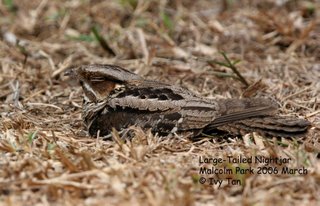
Met up with Nessie, Fee and Ivy for the Annual Bird Census 2006.
We started from the bend of Malcolm Park behind St. Joseph’s Institution.
Perched on the bare branches in the background were some Blue-throated Bee-eaters, a Dollarbird and some Pink-necked Green-pigeons. Javan Mynas were on the ground.
In the trees on the right side of the road, 2 Straw-headed Bulbuls were singing aloud.
Calls of the Collared Kingfisher and Common Iora were heard.
Then we proceeded along Malcolm Road and down the slope to Goldhill garden.
Some men and a ground digging vehicle were by the road.
Some trees were felled and there were patches of soil where the trees used to be.
A lot more Javan Mynas moving on the ground and up in the trees as well.
Long-tailed Parakeets making their noisy calls while perched and also in flight. So were the Collared Kingfishers.
A Tanimbar Cockatoo was making loud harsh screeches up in the tree. Then we saw it chasing after a Rainbow Lorikeet.
Nessie was looking at an Asian Brown Flycatcher, and we were looking for an Asian Koel when a brownish bird flew into the heliconia bush.
I only managed to see some white patches on the wings and the long tail has white outer feathers.
There were 2 eggs lying side by side on the ground. They were about the size of quail eggs, pale brown with black speckles.
 We stayed a while longer, hoping to see the bird come back to her eggs. But we were also worried that we could be giving her undue stress by staying too near for too long, so we moved off quite reluctantly.
We stayed a while longer, hoping to see the bird come back to her eggs. But we were also worried that we could be giving her undue stress by staying too near for too long, so we moved off quite reluctantly.Going back to where we started, the Common Iora finally showed up, after we had a good view of an Oriental Magpie-robin.
After the census, we went back to where the eggs were.
The Large-tailed Nightjar was resting on her eggs!
It’s a relief to know that she did not abandon them.
Full list of birds recorded:
- Banded Woodpecker
- Laced Woodpecker
- Common Flameback
- Dollarbird
- White-throated Kingfisher
- Collared Kingfisher
- Blue-throated Bee-eater
- Blue-tailed Bee-eater
- Asian Koel
- Greater Coucal (heard only)
- Tanimbar Cockatoo
- Red-breasted Parakeet
- Long-tailed Parakeet
- Large-tailed Nightjar
- Spotted Dove
- Pink-necked Green-pigeon
- White-breasted Waterhen
- Golden-bellied Gerygone (heard only)
- Brown Shrike (heard only)
- House Crow
- Large-billed Crow (heard only)
- Black-naped Oriole
- Greater Racket-tailed Drongo
- Common Iora
- Asian Brown Flycatcher
- Oriental Magpie-robin
- Asian Glossy Starling
- Javan Myna
- Hill Myna
- Pacific Swallow
- Straw-headed Bulbul
- Yellow-vented Bulbul
- Common Tailorbird (heard only)
- Dark-necked Tailorbird
- Rufous-tailed Tailorbird (heard only)
- White-crested Laughingthrush
- Scarlet-backed Flowerpecker
- Olive-backed Sunbird
- Crimson Sunbird
- Swiftlet spp
- Rainbow Lorikeet

Ducks
Went to Botanic Gardens during Lunar New Year. Saw some Lesser Whistling-Ducks and Radjah Shelducks. It was the first time that I was observing their eyes at close range and had some interesting findings.
Lesser Whistling-Ducks tend to shut their eyes when preening their feathers, while only saw one Radjah Shelduck doing likewise.
Lesser Whistling-Ducks have brown convex eyes.
Radjah Shelducks have a round of white around the brown iris. The white area seems flat. That makes the eyes look like a button.
Both types have eyelids that shut upwards.
Lesser Whistling-Ducks tend to shut their eyes when preening their feathers, while only saw one Radjah Shelduck doing likewise.
Lesser Whistling-Ducks have brown convex eyes.
Radjah Shelducks have a round of white around the brown iris. The white area seems flat. That makes the eyes look like a button.
Both types have eyelids that shut upwards.
2006 January 14 - Malcolm Park
Contributed by Ian Rickword.
This is an edited version.
After 6 days of continuous rain, the weather smiled on us on Saturday 14th January for the second anniversary reunion of the birdwatching class of 2004. As a result, the birds in and around Malcolm Park were busy drying out or restocking on food, giving us ample opportunity to supervise them. Around base camp (Jane's house) there was a raucous dawn chorus and early sightings of a white-bellied sea eagle and a white-throated kingfisher. After we started moving, three straw-headed bulbuls very kindly perched close by, preening themselves and giving us intermittent blasts of song. Also right outside Jane's house were close and clear views of striped tit-babbler, common iora and Asian brown flycatcher.
Across the long (and wet) grass between Malcolm Road and Goldhill we stopped to feed the mosquitoes and watch a juvenile brahminy kite swoop to a treetop to pick up a green breakfast (frog?) which it proceeded to eat while circling. It all seemed so easy it could probably have taken in a coffee and read the newspaper at the same time. Around Goldhill a black baza posed nicely for us before we headed back to Jane's where a sumptuous breakfast was waiting for us. Many thanks, Jane.
Full list of birds seen and heard:
This is an edited version.
After 6 days of continuous rain, the weather smiled on us on Saturday 14th January for the second anniversary reunion of the birdwatching class of 2004. As a result, the birds in and around Malcolm Park were busy drying out or restocking on food, giving us ample opportunity to supervise them. Around base camp (Jane's house) there was a raucous dawn chorus and early sightings of a white-bellied sea eagle and a white-throated kingfisher. After we started moving, three straw-headed bulbuls very kindly perched close by, preening themselves and giving us intermittent blasts of song. Also right outside Jane's house were close and clear views of striped tit-babbler, common iora and Asian brown flycatcher.
Across the long (and wet) grass between Malcolm Road and Goldhill we stopped to feed the mosquitoes and watch a juvenile brahminy kite swoop to a treetop to pick up a green breakfast (frog?) which it proceeded to eat while circling. It all seemed so easy it could probably have taken in a coffee and read the newspaper at the same time. Around Goldhill a black baza posed nicely for us before we headed back to Jane's where a sumptuous breakfast was waiting for us. Many thanks, Jane.
Full list of birds seen and heard:
- White-Throated Kingfisher
- White-Bellied Fish Eagle
- Greater Racket-Tailed Drongo
- Yellow-Vented Bulbul
- White-Breasted Waterhen (H)
- Dollarbird
- Pink-Necked Green-Pigeon
- Asian Koel (F)
- Straw-Headed Bulbul
- Striped Tit-Babbler
- Common Iora
- Black-Naped Oriole
- Javan Myna
- Asian Brown Flycatcher
- Olive-Backed Sunbird
- Hill Myna
- Arctic Warbler
- Red Lory
- Long-Tailed Parakeet
- Asian Glossy Starling
- Dark-Necked Tailorbird (H)
- Banded Woodpecker (H)
- Yellow-Crested Cockatoo
- Rose-Ringed Parakeet
- Blue-Tailed Bee-Eater
- House Crow
- Brahminy Kite
- Pacific Swallow
- Crimson Sunbird
- Scarlet-Backed Flowerpecker
- Rainbow Lorikeet
- Black Baza
- Greater Coucal (H)
- Spotted Dove
- Common Tailorbird
2006 January 7
Contributed by Doreen Ang.
This is an edited version.
One week into the New Year, AH, NK and I decided to recce some ponds, namely the ones in Marina City Park (site 1) and Tampines Mountain Biking Trail (site 2). Date - Saturday, 7th January 2006.
Site 1:Weather was overcast with light drizzle. Less than a dozen people were around. Only noise pollution was the ear-blasting handheld 'leaf-blower' - thankfully that didn't last long!
On arrival at 0745h, we heard the calling of the Golden-bellied Gerygone, Asian Koel, Collared Kingfisher and the Spotted Dove. One and a half hours spent at this site produced 30 Lesser Whistling-Ducks, 6 Wandering Whistling-Ducks, 2 Brahminy Kites in flight, a Grey Heron, a Purple Heron, Pink-necked Green-Pigeons, White-throated and Collared Kingfishers, Blue-tailed Bee-eaters, Yellow-vented Bulbuls, House crows, White-breasted Waterhen, a sub-adult Common Moorhen among the whistling ducks, Yellow Bitterns (1 juvenile and 1 adult) and a male Asian Koel busy picking Indian cherries. Of interest was a Black-capped Kingfisher which AH first spotted as it flew across the pond at 0850h. Unmistakeable - black cap and red bill.
Over at the Marina South MRT bus-stop, there were a few Common Mynas, a Sunda Woodpecker and a Common Tailorbird.
Site 2:Weather - drizzle to light rain. Grounds very wet with puddles of water in many areas. No bikers save for some plane enthusiasts. Continuous dull droning of vehicles from the adjacent Tampines Expressway.
Site 2 was disappointing. Although the TMBT took us slightly over an hour and a half on foot (1010 - 1145), the walk produced only a pair of Common Flameback (male and female), White-throated Kingfishers, a Pied Fantail (calling aloud), Yellow-vented Bulbuls, Spotted Doves, Javan Mynas, a flock of 10 House Crows in flight, Blue-tailed Bee-eaters, White-breasted Waterhen, a Sunda Woodpecker, 2 Ashy Tailorbirds, Black-naped Orioles, 1 Purple Heron in flight and an adult White-bellied Fish-Eagle perched on a bare tree. We could not make a positive i.d. of an accipiter which suddenly shot across our path in what looked like a bird chase. A search for ducks at the 2 main ponds (on the left and right) yielded nothing.
This is an edited version.
One week into the New Year, AH, NK and I decided to recce some ponds, namely the ones in Marina City Park (site 1) and Tampines Mountain Biking Trail (site 2). Date - Saturday, 7th January 2006.
Site 1:Weather was overcast with light drizzle. Less than a dozen people were around. Only noise pollution was the ear-blasting handheld 'leaf-blower' - thankfully that didn't last long!
On arrival at 0745h, we heard the calling of the Golden-bellied Gerygone, Asian Koel, Collared Kingfisher and the Spotted Dove. One and a half hours spent at this site produced 30 Lesser Whistling-Ducks, 6 Wandering Whistling-Ducks, 2 Brahminy Kites in flight, a Grey Heron, a Purple Heron, Pink-necked Green-Pigeons, White-throated and Collared Kingfishers, Blue-tailed Bee-eaters, Yellow-vented Bulbuls, House crows, White-breasted Waterhen, a sub-adult Common Moorhen among the whistling ducks, Yellow Bitterns (1 juvenile and 1 adult) and a male Asian Koel busy picking Indian cherries. Of interest was a Black-capped Kingfisher which AH first spotted as it flew across the pond at 0850h. Unmistakeable - black cap and red bill.
Over at the Marina South MRT bus-stop, there were a few Common Mynas, a Sunda Woodpecker and a Common Tailorbird.
Site 2:Weather - drizzle to light rain. Grounds very wet with puddles of water in many areas. No bikers save for some plane enthusiasts. Continuous dull droning of vehicles from the adjacent Tampines Expressway.
Site 2 was disappointing. Although the TMBT took us slightly over an hour and a half on foot (1010 - 1145), the walk produced only a pair of Common Flameback (male and female), White-throated Kingfishers, a Pied Fantail (calling aloud), Yellow-vented Bulbuls, Spotted Doves, Javan Mynas, a flock of 10 House Crows in flight, Blue-tailed Bee-eaters, White-breasted Waterhen, a Sunda Woodpecker, 2 Ashy Tailorbirds, Black-naped Orioles, 1 Purple Heron in flight and an adult White-bellied Fish-Eagle perched on a bare tree. We could not make a positive i.d. of an accipiter which suddenly shot across our path in what looked like a bird chase. A search for ducks at the 2 main ponds (on the left and right) yielded nothing.
Subscribe to:
Posts (Atom)

